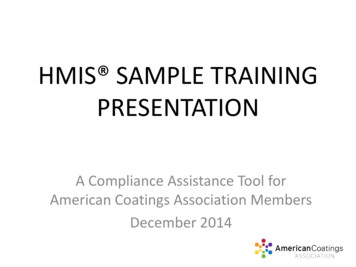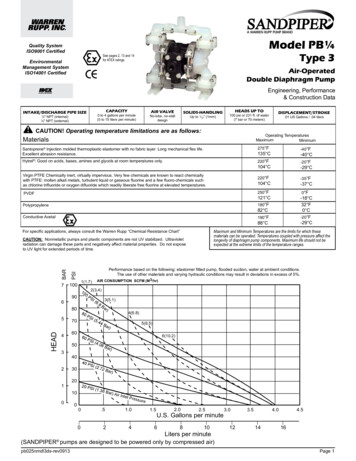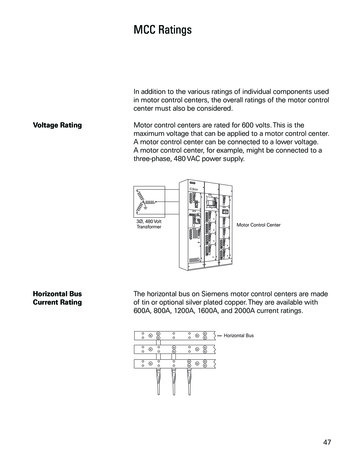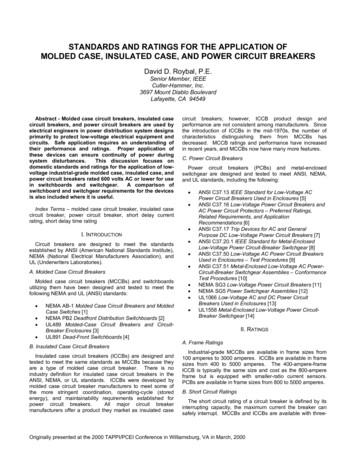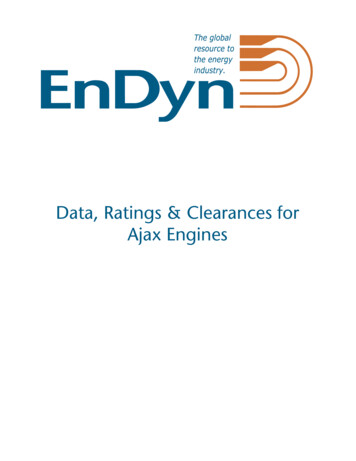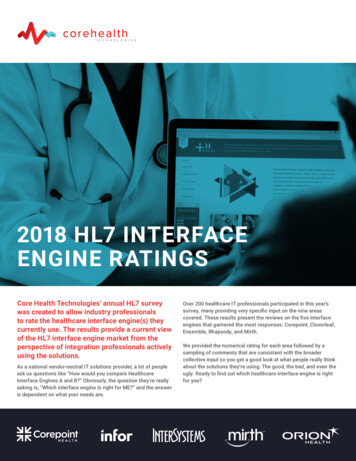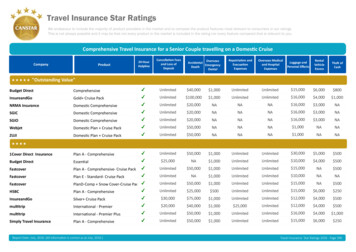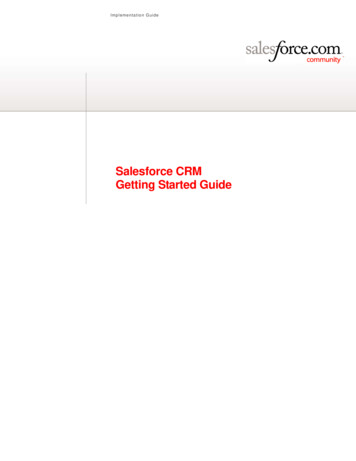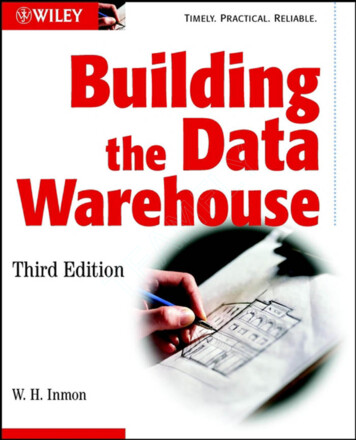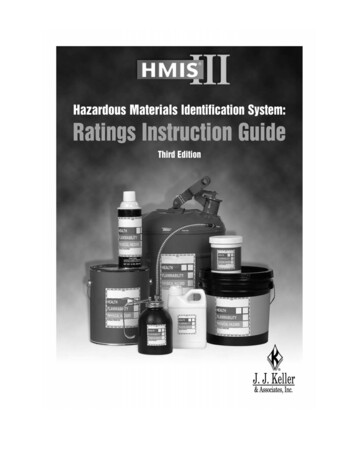
Transcription
HMIS RATINGS INSTRUCTION GUIDE, THIRD EDITIONHazardous Materials Identification System(Third Edition)Ratings Instruction Guide 1981, 1996, 2001 by the National Paint and Coatings AssociationPublished byJ. J. Keller & Associates, Inc.3003 W. Breezewood LaneNeenah, Wisconsin 54957-0368Phone: (800) 327-6868Fax: (800) 727-7516www.jjkeller.comISBN: 1-57943-989-6Canadian Goods and Services Tax (GST) Number: R123-317687All rights reserved. Target organ icons for blood, eye, nervous system, kidney, liver,and respiratory and physical hazard icons for compressed gas, oxidizers, explosives,and pyrphorics are copyrighted materials of Electromark Co. and are used withpermission. Neither the publication nor any part thereof may be reproduced in anymanner without the written permission of the Publisher. United States laws andFederal regulations published as promulgated are in public domain. However, theircompilation and arrangement along with other materials in this publication aresubject to the copyright notice.ii11/01
HMIS RATINGS INSTRUCTION GUIDE, THIRD EDITIONPrinted in the U. S. A.Hazardous Materials Identification System(Third Edition)Ratings Instruction GuidePrefaceHazard assessment is an important requirement of the Occupational Safety andHealth Administration (OSHA) Hazard Communication Standard (HCS) and theprocess of assigning HMIS ratings helps meet that requirement. This documentprovides guidelines for rating materials using the HMIS criteria. Hazard ratings are an integral part of the complete HMIS . They serve as asummary of the hazard assessment process and allow employers to communicateinformation on workplace hazards to their employees who handle hazardouschemical products.As with many HCS-related activities, employers need the cooperation andassistance of product manufacturers to complete the hazard assessment process andproduce HMIS ratings.The supplier, who manufactures and/or distributes a product used in an employer’sfacility, is the one who is the most knowledgeable about the inherent properties ofthe product. This makes a supplier the best qualified to: Assign ratings based on these properties, orSupply data with which such ratings can be developed.This means that the supplier has the option of either providing sufficient information with which an employer can assign HMIS Health, Flammability, andPhysical Hazard ratings, or providing such ratings.Health Ratings While HMIS Health ratings are based upon recognized rating systems, each ofthese systems serves a slightly different purpose and therefore, the Health ratingcriteria (and resulting ratings) are not interchangeable.Flammability RatingsThe HMIS Flammability rating parameters are identical to those contained inOSHA’s 29 CFR 1910.106, Flammable and Combustible Liquids Standard.Definitions of flammable and combustible materials are located in Attachment 1.Eof this guide.iii11/01
HMIS RATINGS INSTRUCTION GUIDE, THIRD EDITIONPhysical Hazards RatingsThe HMIS Physical Hazards ratings parameters are derived from the basicdefinition of ‘‘Physical Hazard’’ contained in the HCS:29 CFR 1910.1200(c) "Physical hazard" means a chemical for which there isscientifically valid evidence that it is a combustible liquid, a compressed gas,explosive, flammable, an organic peroxide, an oxidizer, pyrophoric, unstable(reactive) or water-reactive.The HMIS ‘‘Physical Hazard’’ category consists of seven elements: water reactivity,organic peroxides, explosives, compressed gasses, pyrophorics, oxidizers, andunstable reactives. For simplicity purposes, the HMIS ‘‘Flammability’’ categoryencompasses the rating criteria for ‘‘combustible liquids’’, ‘‘flammable liquids’’, and‘‘pyrophorics’’ as defined by OSHA.Due to the constantly changing nature of government regulations, it is impossible toguarantee absolute accuracy of the material contained herein. The Publisher andEditors, therefore, cannot assume any responsibility for omissions, errors,misprinting or ambiguity contained within this publication and shall not be heldliable in any degree for any loss or injury caused by such omission, error,misprinting or ambiguity presented in this publication. Users of HMIS shouldensure that they become aware of any changes in legislation, OSHA regulations orinterpretations, or litigation relating to hazard communication and ensure thattheir use of HMIS hazard communication tools is consistent with and complieswith such developments. Users should also be aware that HMIS hazardcommunication components are designed to be used in conjunction with each other,and users should, in order to achieve full compliance, completely implement theentire system in order to ensure their program is integrated and effective. Thispublication is designed to provide reasonably accurate and authoritativeinformation in regard to the subject matter covered. It is sold with theunderstanding that the Publisher is not engaged in rendering legal, accounting, orother professional service. If legal advice or other expert assistance is required, theservices of a competent professional person should be sought.The EditorsNational Paint & Coatings AssociationThe PublisherJ. J. Keller & Associates, Inc.iv11/01
HMIS RATINGS INSTRUCTION GUIDE, THIRD EDITIONHazardous Materials Identification System(Third Edition)Ratings Instruction GuidePublished & Printed byJ. J. Keller & Associates, Inc.3003 W. Breezewood LaneNeenah, Wisconsin 54957-0368Phone: (800) 327-6868Fax: (800) 727-7516www.jjkeller.compublisherJOHN J. KELLERNATIONAL PAINT & COATINGS ASSOCIATIONdirector of health and safetyvice president, env., health, & int.counsel, government affairsassoc. director, desktop publishingmanager, communicationsLANCE ‘‘SKIP’’ EDWARDS, CIHSTEPHEN SIDES, CIHALLEN IRISHCATHY BANKSDANIELLE CHALOMJJ KELLER & ASSOCIATES PUBLICATIONS & PRODUCTSpresidentexecutive vice presidentsr. vice president, publications & productscorporate product development managersr. project managersr. product development specialistcorporate manufacturing managervice president of salesROBERT L. KELLERJAMES J. KELLERTERENCE J. QUIRKKEITH D. KELLERGREGORY W. MICHAELPATRICIA A. DEY OLSONDANIEL J. MCGRAWMARK L. TREMBLEJJ KELLER & ASSOCIATES ADMINISTRATIVE SUPPORTsr. vice president, financedirector of information systemscontrollerRONALD M. PHILLIPSTHOMAS C. HUPFROGER E. PORATHThe JJ Keller publications staff is available to provide information generallyassociated with this publication to a normal and reasonable extent, and at theoption of, and as a courtesy of, the Publisher.v11/01
HMIS RATINGS INSTRUCTION GUIDE, THIRD EDITIONvi11/01
HMIS RATINGS INSTRUCTION GUIDE, THIRD EDITIONTable of Contents Chapter 1 Developing HMIS Ratings1.0 Chapter Overview . 1 1.1 HMIS Ratings . 11.2 The Roles of Employers and Their Suppliers. 11.2(A) Health, Flammability and Physical Hazard Ratings. 11.2(B) PPE Codes . 11.3 System Compatibility . 21.3(A) Health Ratings . 21.3(B) Flammability Ratings . 21.3(C) Physical Hazards Ratings. 21.4 General Considerations . 21.4(A) Information for Generating the Ratings. 21.4(B) Using Professional Judgment. 31.4(C) Normal Conditions of Use Apply. 31.4(D) Special Considerations for Mixtures. 31.5 The Health Hazard Rating. 31.5(A) Basis for the Health Hazard Rating . 31.5(B) Assigning the Chronic Health Hazard Asterisk (*). 51.5(C) Assigning the Acute Health Numerical Rating. 61.6 The Flammability Rating . 71.6(A) Basis for the Flammability Rating. 71.6(B) Assigning the Flammability Rating. 71.7 The Physical Hazards Rating . 71.7(A) Basis for the Physical Hazards Rating . 71.7(B) Assigning the Physical Hazards Rating . 7Attachment 1.A: Draize and Primary Irritation Index (PII) Criteria for Scoring theDegree of Chemical Irritancy to Skin and Eyes . 21Attachment 1.B: Approximation of the HMIS Inhalation LC50 Criteria in ppm Units . 23 Attachment 1.C: HMIS Rating Classification Data Sheet. 25 Attachment 1.D: The HMIS Rating Process: Suggested Guidelines for ClassifyingMaterials. 27Attachment 1.E: Definitions of Flammable and Combustible Liquids(29 CFR 1910.106). 30 Chapter 2 HMIS Rating Examples2.0 Chapter Overview . 352.1 Example Data . 352.1(A) Acetylene ------ COMPRESSED GAS . 352.1(B) Benzoyl Peroxide ------ ORGANIC PEROXIDE . 392.1(C) Fuming Nitric Acid ------ OXIDIZER. 432.1(D) Nitroglycerin Based Explosives ------ EXPLOSIVE. 472.1(E) Nitromethane ------ UNSTABLE REACTIVE. 512.1(F) White Phosphorus ------ PYROPHORIC . 552.1(G) Sodium ------ WATER REACTIVE . 592.1(H) Sodium Hydride ------ WATER REACTIVE . 632.1(I)Styrene ------ UNSTABLE REACTIVE . 67vii11/01
HMIS RATINGS INSTRUCTION GUIDE, THIRD EDITIONviii11/01
HMIS RATINGS INSTRUCTION GUIDE, THIRD EDITION Chapter 1 Developing HMIS Ratings1.0Chapter OverviewHazard assessment is an important requirement of the OSHA’s HCS and the process of assigning HMIS ratings helps meet that requirement. This document provides guidelines for rating materials using the HMIS criteria. 1.1HMIS Ratings Hazard ratings are an integral part of the complete HMIS . They serve as a summary of thehazard assessment process and allow employers to communicate information on workplacehazards to their employees who handle hazardous chemical products.As with many HCS-related activities, employers need the cooperation and assistance of product manufacturers to complete the hazard assessment process and produce HMISratings.1.2The Roles of Employers and Their Suppliers1.2(A) Health, Flammability, and Physical Hazards RatingsThe supplier, who manufactures and/or distributes a product used in an employer’s facility,is the one who is the most knowledgeable about the inherent properties of the product. Thismakes a supplier the best qualified to: Assign ratings based on these properties; orSupply data with which such ratings can be developed.This means that the supplier has the option of either providing sufficient information with which an employer can assign HMIS health, flammability, and physical hazard ratings, orproviding such ratings.1.2(B) PPE CodesOSHA’s PPE standards (contained in 29 CFR 1910, Subpart I) require that employersdetermine the proper PPE needed in their workplaces. Additionally, employers are the oneswho are most knowledgeable about the PPE necessary for the actual conditions underwhich products and materials are used in their facilities. Thus, the designation of theproper PPE is the responsibility of the employer.The information provided by suppliers on product MSDSs will be used by employers todetermine the proper PPE for their employees who work with the products. To provideprotection for all routes of entry for a hazardous material, the supplier should be sure thatthe following protective equipment is considered on the MSDS: Eye Contact: safety glasses, splash goggles, face shield, etc.;Skin Contact: gloves, apron, boots, or full protective suit, etc.; andInhalation and Possible Ingestion: appropriate NIOSH approved respirators andfilter/cartridge types.CHAPTER 1-111/01
HMIS RATINGS INSTRUCTION GUIDE, THIRD EDITIONThe employer will review the recommendations made by the supplier and, based on anassessment of product use and control procedures (quantity, aerosolization,
Chapter 1 Developing HMIS Ratings 1.0 Chapter Overview Hazard assessment is an important requirement of the OSHA’s HCS and the process of assigning HMIS ratings helps meet that requirement. This document provides guidelines for rating materials using the HMIS criteria. 1.1 HMIS Ratings Hazard ratings are an integral part of the complete HMIS . They serve as a summary of theFile Size: 203KBPage Count: 20

